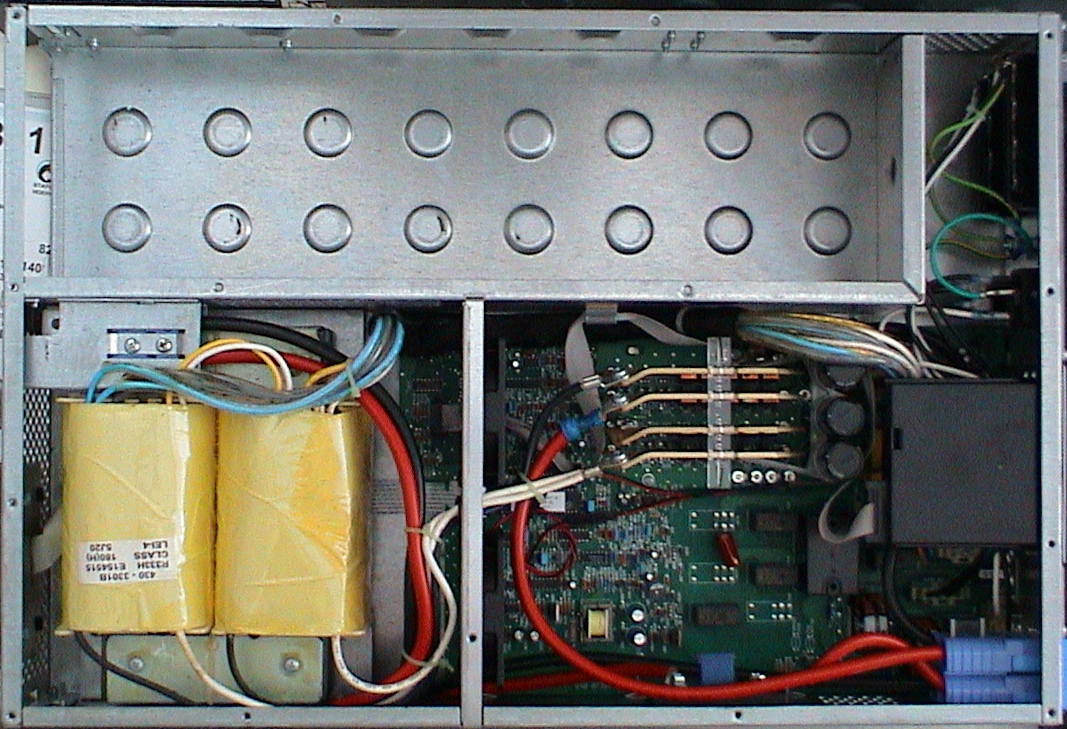Installation and Configuration of a APC UPS using apcupsd
- American Power Conversion Battery Driver Download Windows 10
- American Power Conversion Battery Driver Downloads
American Power Conversion (APC) SONY Fingerprint Sensor 3500 Free Driver Download for Windows Vista, 2003, XP, 2000, NT4, ME, 98SE, 98, 95. After trying to use an APC biometric fingerprint reader with Windows 7. Rebate coupon distributor sample download review driver save. Download APC Biopod Linux Driver for free. When such option is in effect, the core driver will ignore LB state as reported by specific driver and start shutdown basing the decision only on two conditions: battery.charge battery.charge.low OR battery.runtime battery.runtime.low Of course - if any of the variables are not available, the appropriate condition is not checked. The 48 V Battery Pack from APC® is designed to provide a stable power management for your Smart-UPS XL. It enables intelligent battery management. This Hot Swappable battery is equipped with cascading capabilities, Hot Pluggable Operation and is accompanied with a rack mount. American Power Conversion (APC) is a leading manufacturer of uninterruptible power supplies (UPS) and surge protection products for end-to-end legendary reliability. In Device Manager Human Interface Devices, I should see 'American Power Conversion USB UPS' as a listed device, but I do not. When I boot this computer as Linux it does see the device as, 'Back-UPS ES 650G1 FW:906.W1.D USB FW:W1' (and more info). I am concluding that something is wrong with Windows 10's ability to see this device.
This web-page consists of four sections: Introduction, installation,configuration, and statistics.
1. Introduction
Since one of our machines is configured as print server and because it doesother monitoring jobs, I wanted to equip it with an uninterruptable power supply(UPS). Having read already years ago, that there are Linux drivers for UPS'sfrom APC (American Power Conversion) and having seen such a device inan electronics store (Mediamarkt) for Swiss Francs 79.- (about Euro 50.-),I bought the UPS 'APC Back-UPS CS 350 Battery Backup 350'.
2. Installation of Hardware and Software
The installation of the hardware is easy and explained in the manual (and thanksto the company APC there is a printed manual included, not just a CD, whichneeds a Micro$oft program to read it).
Besides the power cables I also connected the data cable, which on one end(at the UPS) has a RJ-45-like plug and on the other end (at the PC) anUSB plug.
Software installation under Debian (Sarge) Linux with Kernel 2.4.26 is easyas well:
apt-get install apcupsd (and answer 'Y' when asked during installation)
3. Configuration of apcupsd
Useful information about the configuration of apcupsd can also befound on http://www.apcupsd.com/ (there,click on 'Online Manual')
Should you have a 2.6 Kernel, such as Kernel 2.6.7 as we use it, you shouldfirst do a few steps (if you use a 2.4 kernel, such as kernel 2.4.26, as we did,skip the following lines):
- Add the following line into your /etc/fstab:
none /sys sysfs defaults 0 0
- Then enter mount /sys
- Make sure, the USB subsystem is there and enter ls -l /sys/bus/usb/drivers
- If 'hiddev' is not there, you have a problem. We had this problem as wellafter having upgraded from a 2.4 to a 2.6 kernel and got an error-messagewhen entering apcaccess. I did two things, which helped to resolvethe problem:
- 1. apt-get remove apcupsd followed by a apt-get install apcupsd
- 2. Plug out and plug in again the USB cable on the PC - then things worked fine again!
We continue the description for 2.4 kernels...Now, let's check, whether the connected device was detected:
cat /proc/bus/usb/devices reveals (among many other lines):Ok, the last line tells us, that there is no driver. We load the driver intothe kernel by entering:
modprobe hid and enter again cat /proc/bus/usb/devices; nowwe see:(With a 2.6 kernel you will see 'Driver=usbhid' on the line above).
So now the driver 'hid' is activated. We can verify this as well by entering
cat /proc/bus/usb/drivers.
In order to have this driver loaded at next boot, we enter two lines in/etc/modules:
# for apcupsd:
hid
The next step is to create appropriate device files. The installation comeswith a script, which creates these. Simply enter:
/usr/share/doc/apcupsd/examples/make-hiddev
However, trying to start 'apcupsd' by entering the command:
/etc/init.d/apcupsd start
results in a comment like: 'Please check your configuration and then remove this warning to make apcupsd work'.In order so follow, what is happening, you should enter (in a separatewindow) the command:
tail -f /var/log/apcupsd.events and you may watch what is going on.
So we edit the file /etc/init.d/apcupsd and comment the three lines:After starting acpupsd again, we get the following message:It's time to edit the file /etc/apcupsd/apcupsd.conf and there weread, for USB devices we should set the variable DEVICE as follows:
DEVICE /dev/usb/hiddev[0-15] ... That's wrong! After startingapcupsd we get the message:Why this? A closer look in /usr/share/doc/apcupsd/examples/make-hiddev givesthe explanation: the device files are not created under /dev/usb but under/dev/usb/hid! So we again edit /etc/apcupsd/apcupsd.conf and set:
DEVICE /dev/usb/hid/hiddev[0-15]
But now we get - when starting apcupsd - the following message:Same error again? Mhh... Maybe, we should modify the cable type in theconfiguration file; so we edit /etc/apcupsd/apcupsd.conf again and set:
UPSTYPE usb (instead of UPSTYPE smartups) and we enteragain:
/etc/init.d/apcupsd start
American Power Conversion Battery Driver Download Windows 10
Now we see in the file /var/log/apcupsd.events that things finallywork:
Mon Oct 04 15:02:58 CEST 2004 apcupsd 3.10.15 (04 August 2004) debian startup succeeded
The entries in /etc/apcupsd/apcupsd.conf without the commented lines look asfollows:
4. Statistics of apcupsd

We now may run the command apcaccess and view some statistics andinformation. Among other lines we get the output:However, the number of TIMELEFT is misleading! Let's now plug off the power tothe USV and after a minute or plug it in again. We now obtain:which is more realistic, since we have connected to the UPS not only aPC with a Pentium 4, but also a flat screen, an 8-port switch and anADSL-router. From now on, the UPS reports the correct values.
There are other interesting statistical values given, such as:
And, a power failure produces the following entries in the logfile/var/log/apcupsd.events :The only thing, which helped, was to unplug the USB-plug at the PC and toplug it in again. Then I entered:/etc/init.d/apcupsd restart
From then on things worked fine again!

When I clicked on it, I saw that the system was now providing information on the UPS charge just as if I had a laptop running on battery power, though thesystem is a desktop system. As the UPS was charging, I saw information on its charge state and when it was fully charged, clicking on the power icon in the system tray showed 'fully charged' for the UPS battery.


Going to the Control Panel using Ctrl-Esc then clickingon Hardware, then selecting Device Manager showed'HID UPS Battery' beneath 'Batteries'.
Double-clicking on it opened a HID UPS Battery Propertieswindow that showed 'on American Power Conversion USB UPS' for 'Location'under the General tab, so the operating system did recognizethe manufacturer of the UPS.
Clicking on the Events tab, I saw that the driver name washidbatt.inf.
To configure the actions Windows will take when the battery powerbecomes very low, I went to the Control Panel, then selectedSystem and Security and then Power Options.
The 'Balanced' power plan was selected; I clicked on 'Change plan settings'.Then at the Edit Plan Settings widow, I clicked on 'Change advancedpower settings'.
I then clicked on 'Change settings that are currently unavailable' at thePower Options window, since otherwise I would be unable to change the settings.
I then scrolled down to Battery and clicked on the plus signto the left of it, so that I could expand it to see the options within it.
The setting for 'On battery' within 'Critical battery action' was 'Shut down'.
I changed it to 'Hibernate'. I had previously enabled hibernation modefor the system as explained at Enabling hibernation on a Windows Server 2012 Essentials system.
I then clicked on OK, which took me back to the Edit PlanSettings window.
The Save changes button there was grayed out, but that didn'tmatter. When I closed the window and then reopened it and checked the settingsgoing through the steps above again, I found that the option to hibernatewhen on battery for 'Critical battery action' was set.
References:
- Setting up Hyper-V with a UPS
By: Benjamin Armstrong
Date: October 22, 2009
MSDN Blogs
American Power Conversion Battery Driver Downloads
Justdeals Daily Electronics Deals
Created: Saturday February 21, 2015